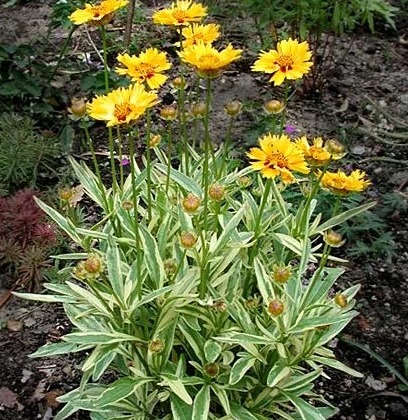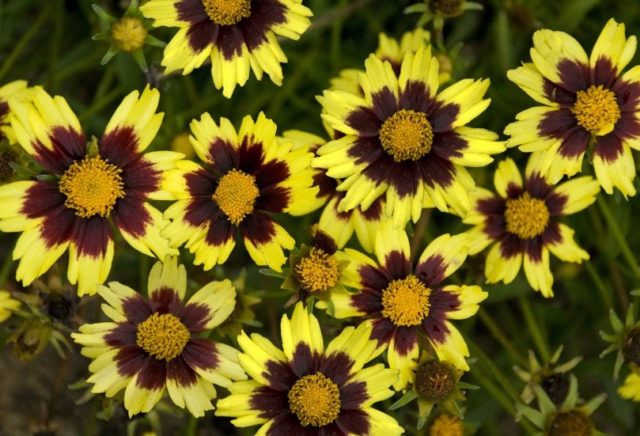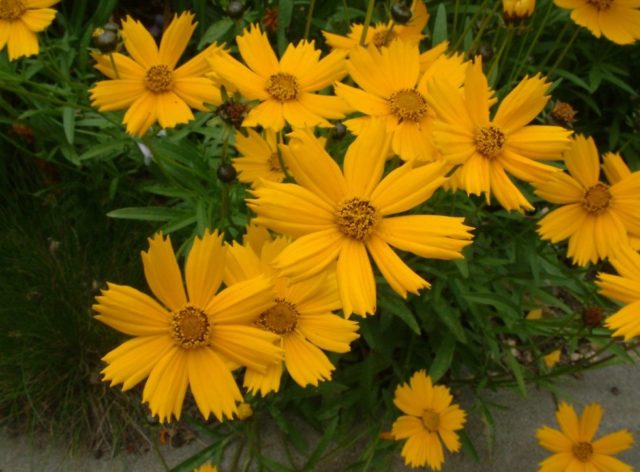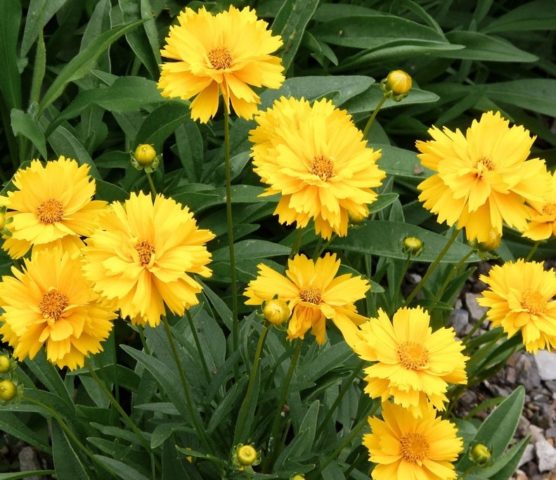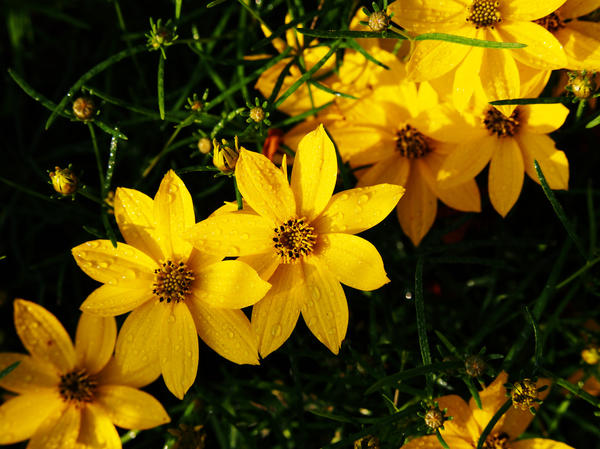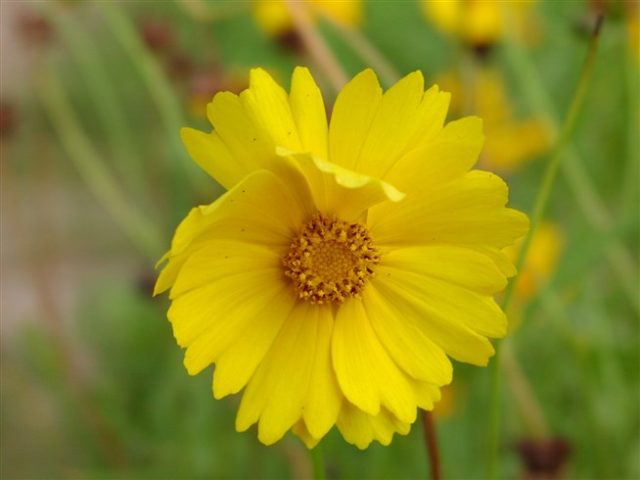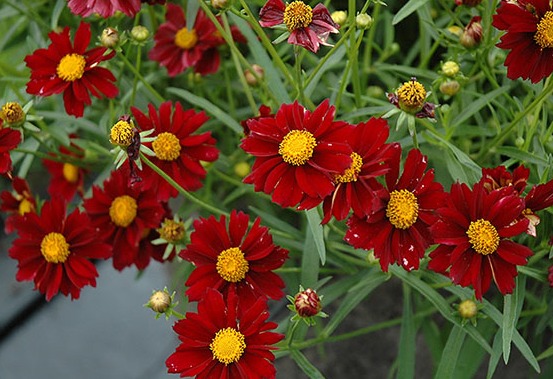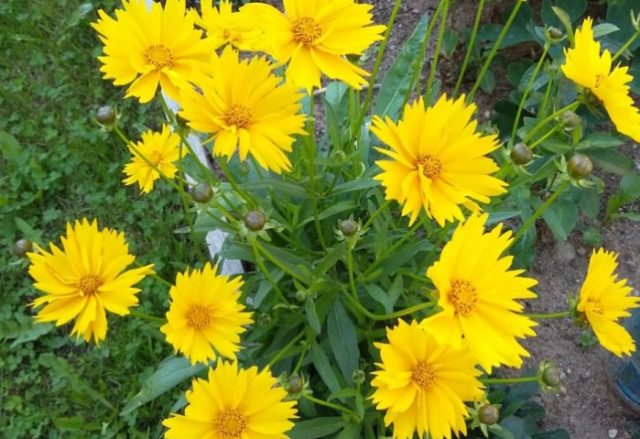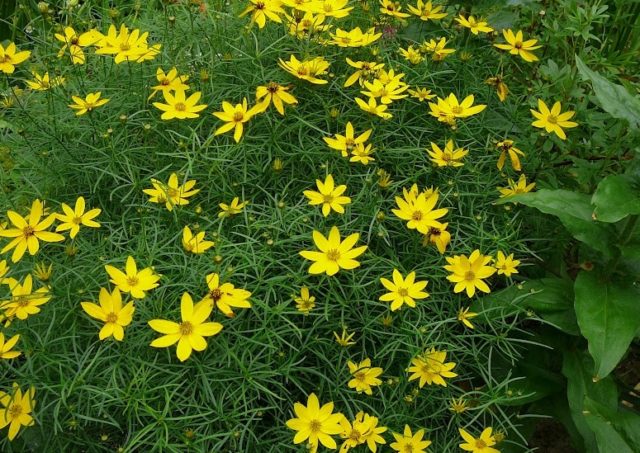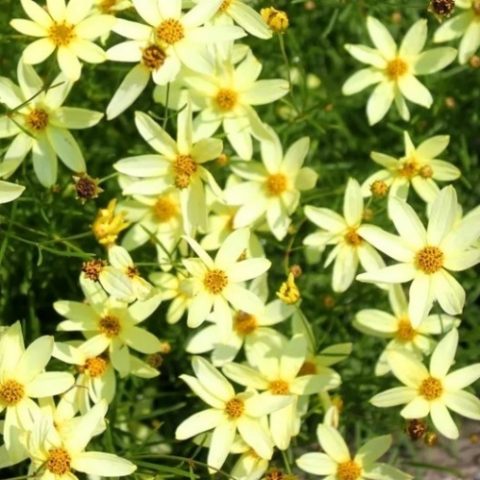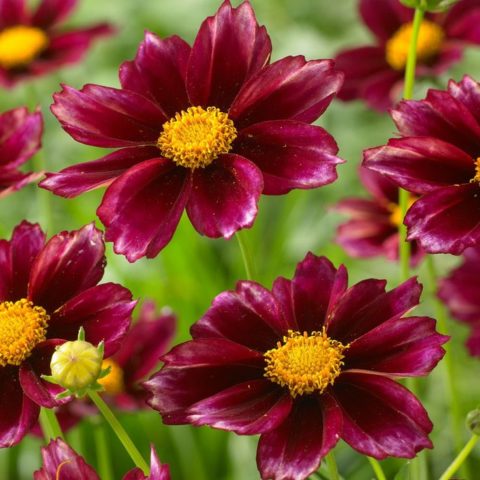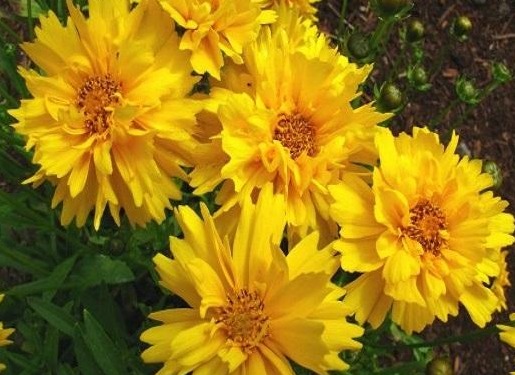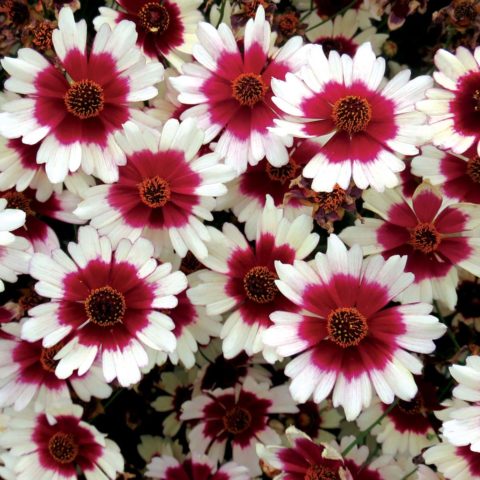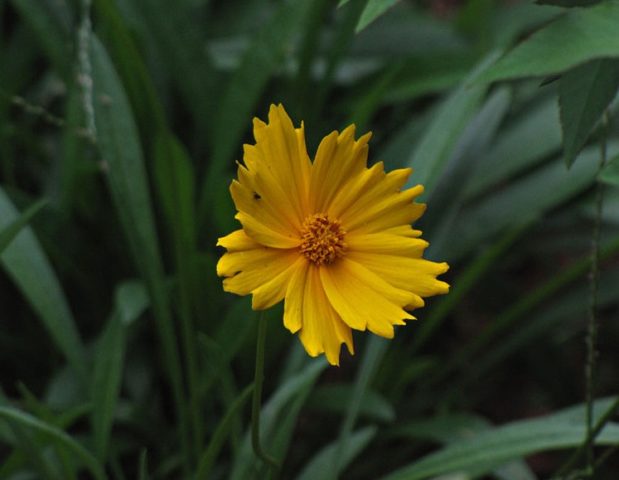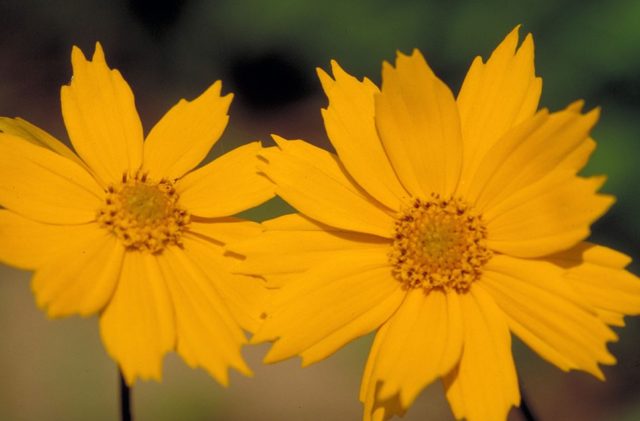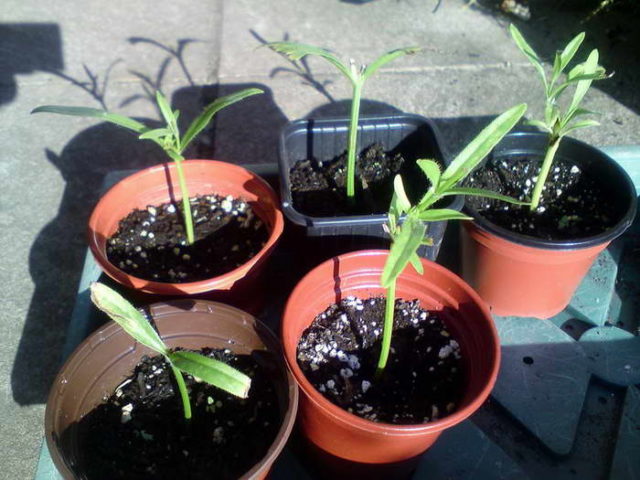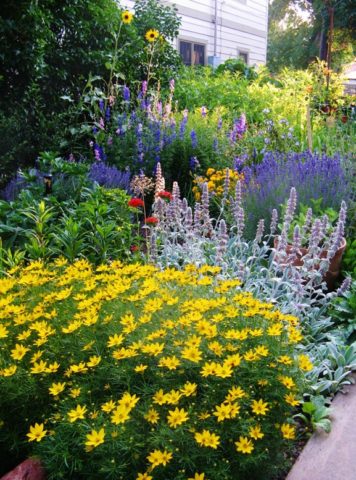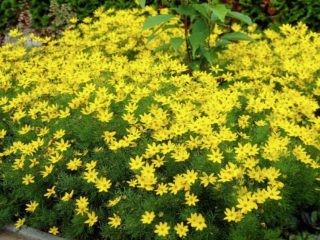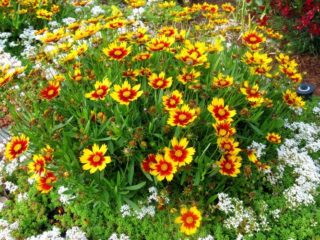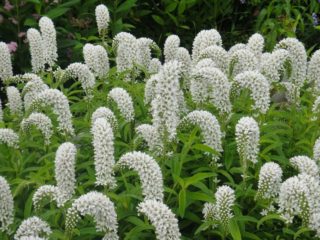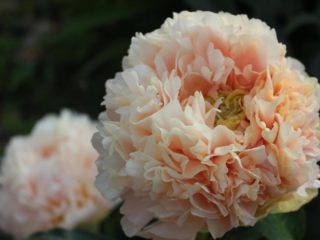Content
Planting and caring for perennial coreopsis will not be difficult. In nature, this bright flower often grows on infertile soils, it withstands drought and temperature extremes well. Therefore, caring for perennial coreopsis is reduced only to rare watering and periodic pruning of wilted inflorescences. Everyone can cope with such a simple task.
Description and characteristics
Perennial Coreopsis belongs to the Astrovye family. This is a low-growing shrub that usually grows no more than 100 cm. The leaves are bright green, dissected, finger-shaped, and sometimes whole. They are located opposite (opposite each other).
Perennial coreopsis is a very unpretentious plant: in natural conditions it can be found even on depleted sandy soils, including abandoned wastelands and along roadsides. The root system allows you to get maximum moisture. Therefore, perennial coreopsis feels good even in a dry season.
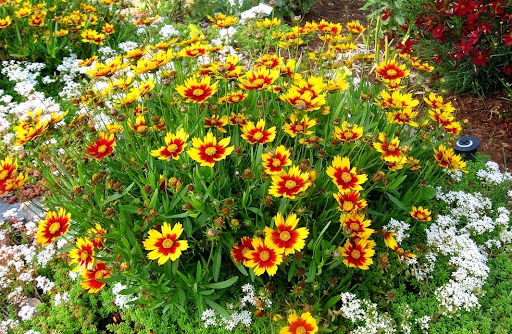
Coreopsis produces low, fairly compact bushes
Flowering time of coreopsis
Coreopsis blooms throughout the summer - i.e. from June to September inclusive. In some species, flowers can appear even in October, until the first frost occurs. To maintain a lush bloom, it is recommended to regularly remove faded parts.
Perennial coreopsis petals are painted in different colors:
- yellow;
- Orange;
- brown;
- pink;
- marble.
There are both monochromatic and two-colored inflorescences (for example, yellow and chocolate shades). Flowers can be either simple or double-shaped (lush, with several rows of petals).
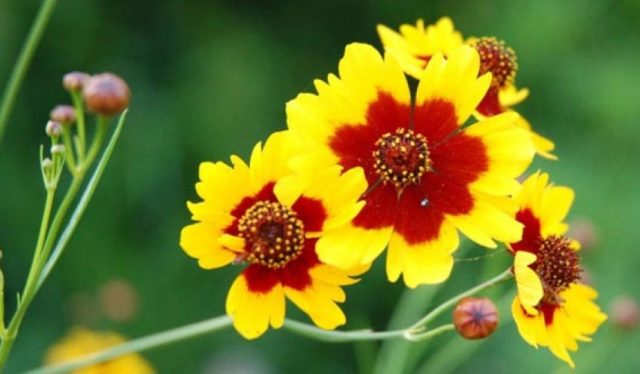
Bright bicolor coreopsis petals are clearly visible even in remote corners of the garden
Perennial coreopsis varieties
There are more than 100 species in the genus of perennial coreopsis (Coreopsis), and only 10% of them are actively used in culture. The most common are described below.
Large-flowered (grandiflora)
This type of perennial coreopsis is found in North America. Belongs to tall - highly branching shoots reach a height of 100 cm. Leaves are narrow, longitudinal, dissected type (basal leaves are simple), rich green color.
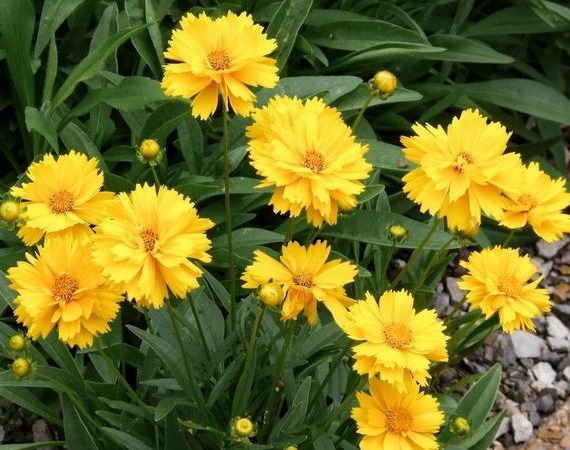
The species got its name due to the very large flowers that grow up to 7-8 cm in diameter.
There are several varieties:
- Calypso (Calypso) - variegated representative with yellow petals with a red core;
- Baden Gold (Baden Gold) is one of the tallest varieties;
- Sunburst (Sunburst) - tall crop of sunny colors;
- Sunray (Sunray) - medium-sized bush with lemon terry inflorescences;
- Sandancer (Sundancer) is a dwarf subspecies with a height of 20-30 cm.
Lanceolate
Lanceolate (lanceolata) is another American species of coreopsis. The bush is medium-sized, the shoots branch well, reach a height of 50-60 cm. Leaves are of a simple type, flowers are up to 6 cm in diameter, yellow. Blooms mainly in the second half of summer, for 8 weeks in a row.
Popular varieties of this species:
- Golden queen (Golden Queen) - perennial 50-60 cm high, basket diameter - 6 cm;
- Robin (Rotkehlchen) - grows in length up to 45 cm, diameter of inflorescences - 5 cm;
- Goldfin (Goldfink) - undersized (20-30 cm) perennial coreopsis.
Whorled
The whorled species (verticillata) gives powerful, vigorous bushes up to 100 cm high. The leaves are very narrow, therefore they resemble needles of a dark green color. The flowers are small, 2-3 cm in diameter, but numerous. In addition, they attract attention with their bright yellow color, which looks especially attractive against the background of foliage. The flowers of this perennial coreopsis resemble stars.
Begins to bloom in mid-July, inflorescences appear for more than two months. It grows without replanting to a new place up to 5-6 years. The most common varieties are:
- Zagreb (Zagreb) - undersized (20-30 cm), golden flowers.
- Moonbeam (Moonbeam) - also undersized, with cream or light yellow flowers.
- Mercury rising (Mercury Rising) is a beautiful perennial coreopsis variety with cherry petals and a yellow heart.
- Golden shower (Golden rain) is a medium-sized bush (height 60-70 cm) with golden flowers.
Pink (rosea)
One of the most interesting types of perennial coreopsis: a bush up to 30-40 cm, two-color petals (pale pink with a red heart).

Pink coreopsis blooms all summer, capturing even September
Popular varieties:
- Sweet dreams (Sweet dreams) - crimson petals, with a white border and a yellow core.
- Heaven's Gate (Heavenly gates) - undersized (20-40 cm), flowers of a rich pink and purple hue.
Auricular (auriculata)
This is a stunted species of perennial coreopsis, branches grow up to 20-30 cm. Flowers are lemon-yellow.
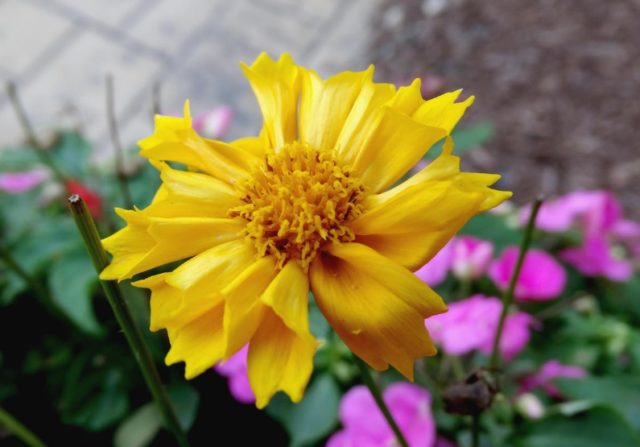
Ear-shaped coreopsis attracts attention with its pleasant color and graceful shape
Gardeners prefer these varieties of this perennial culture:
- Nana (Nana) is a small, dense bush with oval leaves. It begins to bloom in the spring, the inflorescences are yellow and orange. Blooming may begin again in the fall.
- Zamphir (Zamfir) is a small shrub with golden orange flowers.
Reproduction of coreopsis
Breeding perennial coreopsis is quite simple. It can be grown from seed, cuttings or new plants can be obtained by dividing the mother bush.
Dividing the bush
This is the easiest way. You can divide adult bushes that are at least 3-4 years old. The procedure begins in early spring, when the snow has already melted, but the phase of active growth has not yet begun. Sequencing:
- The earth around the bush is loosened.
- Then it is cut around the perimeter so that it can be dug up along with the earthen lump.
- Carefully remove, trying not to damage the roots.
- They take a sharp knife and cut several divisions so that each of them has 2-3 kidneys.
- They are seated in a permanent place and then looked after in the same way as for an adult seedling.
Cuttings
Perennial coreopsis can also be bred by cuttings. To do this, at the beginning of summer, you need to get several green petioles. The sequence of actions is simple:
- Several healthy shoots are selected.
- Cut off the lower part under the leaves (8-10 cm below the internode).
- Placed in a pot with ordinary soil (garden soil) - 2-3 petioles in a container.
- Moisturized and grown directly on the street in partial shade from a shrub, tree or structure.
- Watered regularly, and after 1.5-2 months they are planted in a permanent place.
Growing coreopsis from seeds
The term for planting perennial coreopsis seeds for seedlings is March or early April. Any soil can be used - universal for flower seedlings or your own mixture of garden soil, humus, compost (2: 1: 1) with the addition of a few pinches of coarse sand. Initially, seeds of perennial coreopsis are planted in common containers (containers, boxes), then they are dived into cups.
The sequence of actions is standard:
- The soil and containers are disinfected in a 1-2% solution of potassium permanganate or 3% hydrogen peroxide solution.
- A small (3-4 cm) layer of small stones is placed on the bottom. Several drainage holes are made if necessary.
- Seeds are planted at a distance of 5 cm from each other, without deepening (it is enough to sprinkle it with earth a little with sand).
- Spray with water.
- Cover with a lid and put on the windowsill (the temperature should be at room temperature).
- They dive after the appearance of three true leaves.
- A week later, a liquid complex fertilizer is applied.
- 2-3 weeks before transplanting perennial coreopsis seedlings into the ground, it is periodically taken out to the balcony or outside (temperature 15-16 ° C).
Planting and caring for Coreopsis flowers
It is quite easy to care for perennial coreopsis in the garden. This is one of the most unpretentious plants that needs only timely watering and pruning.
Sowing and planting dates in open ground
You need to prepare for planting seeds at the end of February. The specific period depends on the region:
- in the middle lane, seedlings of perennial coreopsis begin to grow in mid-March;
- in the southern regions - in early spring;
- in the Urals, Siberia and the Far East - at the end of the month or in the first decade of April.
The seedlings of perennial coreopsis are transferred to the flower bed in mid-May (if the spring is cool - towards the end of the month).
Sowing seeds and caring for seedlings
There are two ways to propagate coreopsis by seeds:
- Seedless - seeds are planted in open ground in May or June, moistened, covered with a film, and in July-August they dive to a permanent place.
- Seedling - the traditional way described above. It is quite simple to care for seedlings - they can be obtained in normal room conditions.
If you grow the bushes in the first way, they will give flowers only for the next season, and if you get seedlings, flowering will begin in the same year.
Site and soil preparation
The place for planting perennial coreopsis is chosen depending on the composition, as well as on several practical points:
- the site should be illuminated - even a weak partial shade is undesirable;
- hills are preferable - water accumulates in the lowlands;
- if the variety is tall, it is important to provide protection from strong winds.
The site is pre-cleaned and dug up. If the soil is fertile, you do not need to fertilize it additionally. If the soil is depleted, it is necessary to apply 50-60 g of complex mineral fertilizer for each square meter. It is not necessary to do this - top dressing can also be repaired into the holes during planting.
If the soil is heavy, clayey, then when digging into it, you need to add coarse sand - 200-300 g per 1 m2.

Before planting, the area must be cleaned and dug up to half the bayonet of the shovel
Planting coreopsis in open ground
The sequence of actions when planting on a flower bed:
- Several pits are formed. The depth is determined by the size of the rhizome, and the distance - depending on the variety: for the undersized, an interval of 15-20 cm is left, for the tall ones - 30 cm.
- A drainage layer (pebbles, broken brick, other small stones) is laid at the bottom of the hole.
- If the soil is infertile, prepare a mixture of garden soil with peat (in equal amounts), superphosphate and potassium salt (a pinch for each pit).
- The seedlings are rooted and the ground is lightly tamped.
- Water and mulch abundantly with straw, sawdust, hay or other materials at hand.
Follow-up care
In the future, caring for coreopsis comes down to a few simple rules:
- It needs to be watered regularly, avoiding complete drying out and cracking of the soil. The volume of water should not be too large, and during the rainy period, it is not necessary to give excess liquid at all.
- If fertilizers have already been applied to the planting pit, it is not necessary to feed perennial coreopsis in the first season.And starting from next year, you can give a complex mineral fertilizer in the spring, during flowering and after its end (but not later than August).
- Withered inflorescences are immediately cut off. Thanks to this, new flowers will appear, which will also have time to decorate the garden.
- The soil is periodically loosened, especially 1-2 days after watering or feeding.
- If the coreopsis is tall, and winds often blow on the site, it is advisable to put a wooden peg and tie a plant to it.
- For the winter, they carry out total pruning at the root (leave hemp 4-5 cm) and cover with a layer of mulch - spruce branches, dry foliage, hay. In the south, it is not necessary to do this - there coreopsis will be able to endure the winter without shelter.
When can coreopsis be transplanted?
Coreopsis grows for a long time in the same place in the garden. But since the culture is perennial, the bush begins to thicken and age. Therefore, at least once every 4-5 years, it needs to be transplanted, i.e. divide into several parts.
To do this, in early spring, the bush is dug up and several divisions with two healthy buds are obtained. Then they are transplanted to a new place, leaving an interval of 15-30 cm (depending on the characteristics of the variety).
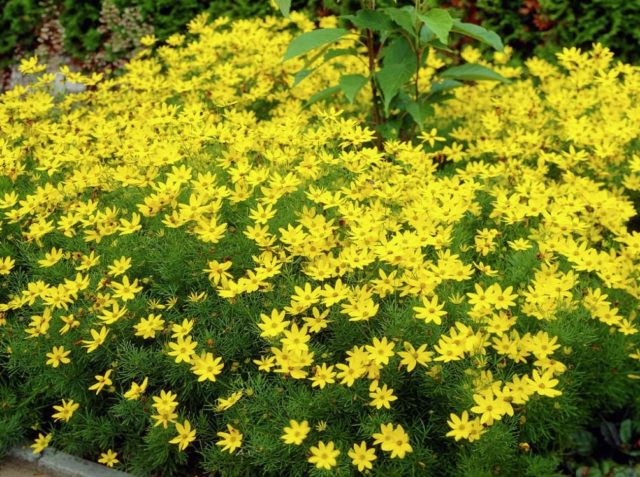
It is advisable to replant adult bushes of perennial coreopsis at least once every 4-5 years.
Diseases and pests
Different types and varieties of perennial coreopsis have a fairly good immunity, so they do not often suffer from diseases. But sometimes plants can be affected by various infections:
- rust;
- fusarium;
- leaf spot;
- tobacco mosaic.
Therefore, in the spring (in April or May), it is recommended to treat the bushes with any fungicide:
- "Tattu";
- "Ordan";
- Fitosporin;
- "Profit";
- "Topaz";
- bordeaux liquid.
In summer, aphids and some beetles can parasitize on the leaves of perennial coreopsis. They are removed by hand or washed off with water. Then a solution of any insecticide should be sprayed over the plants:
- Aktara;
- "Spark";
- "Decis";
- "Confidor";
- "Fufanon".
You can also use folk remedies - a decoction of tomato tops, an infusion of wood ash, tobacco dust, garlic, onion husks, chili peppers and other recipes.
Coreopsis in landscape design
Thanks to its graceful and very bright flowers, coreopsis literally brings the garden to life. The plant is unpretentious, so it can be planted anywhere - both in the very center of the flower garden, and around the perimeter to create a pleasant background and organize the space.
The photo shows several interesting options for using perennial coreopsis to decorate a garden:
- Along the road.
- On rocky hills.
- Single boarding next to the road.
- In composition with other colors (better with blue, lilac shades).
- Near the fence, in pots.
Perennial coreopsis can be planted around the perimeter of the lawn, used in mixborders, multi-tiered flower beds, in rock gardens and other compositions.
Conclusion
Planting and caring for Coreopsis perennial is really simple. The bushes take root well on both light and heavy soils and do not require special attention. In the future, the culture will spread on the site very quickly, since self-seeding is possible. Therefore, it is better to cut off the inflorescences immediately after wilting, so as not to allow the fruits (dry bolls) to form.
